-
Scam Alert. Members are reminded to NOT send money to buy anything. Don't buy things remote and have it shipped - go get it yourself, pay in person, and take your equipment with you. Scammers have burned people on this forum. Urgency, secrecy, excuses, selling for friend, newish members, FUD, are RED FLAGS. A video conference call is not adequate assurance. Face to face interactions are required. Please report suspicions to the forum admins. Stay Safe - anyone can get scammed.
-
Several Regions have held meetups already, but others are being planned or are evaluating the interest. The Calgary Area Meetup is set for Saturday July 12th at 10am. The signup thread is here! Arbutus has also explored interest in a Fraser Valley meetup but it seems members either missed his thread or had other plans. Let him know if you are interested in a meetup later in the year by posting here! Slowpoke is trying to pull together an Ottawa area meetup later this summer. No date has been selected yet, so let him know if you are interested here! We are not aware of any other meetups being planned this year. If you are interested in doing something in your area, let everyone know and make it happen! Meetups are a great way to make new machining friends and get hands on help in your area. Don’t be shy, sign up and come, or plan your own meetup!
You are using an out of date browser. It may not display this or other websites correctly.
You should upgrade or use an alternative browser.
You should upgrade or use an alternative browser.
Mystery Shaper rejuvenation
- Thread starter kevin.decelles
- Start date
Alrighty! Engine and Transmission time!
Got the motor and tranny mounted this past weekend, changed out the chain to one w/adjustable linkage, and affixed 3 new belts.
The tranny bolts on w/4 bolts to the main casting. To adjust chain tension the bolts had been let out and a 1/4 flat bar was inserted behind as a shim. I changed this out to use 4 studs w/adjusting nuts instead. This makes chain adjustments easy. First two pics show it bolted (no pic of the sagging chain which prompted the use of the stud, picture #3 shows the changeover to studs).
The clutch mechanism is currently still disassembled as I need to make new engagement-shoes. Happy to say the motor runs smoothly and the tranny functions as expected (engaging clutch with a piece of wood. The yoke is out as well so the ram has yet to move.
Went with ISO68 in the gearbox. Original design - no drain plug. I drilled/tapped one in as an upgrade.
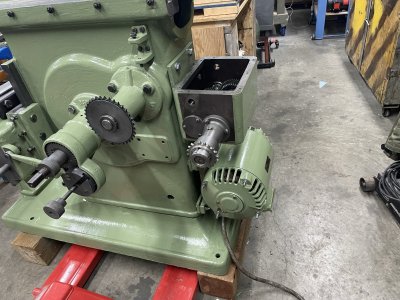
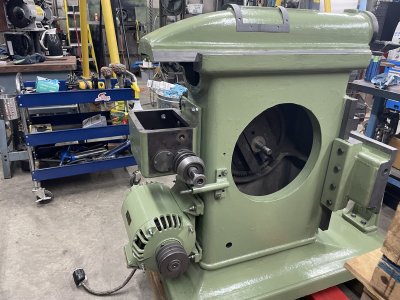
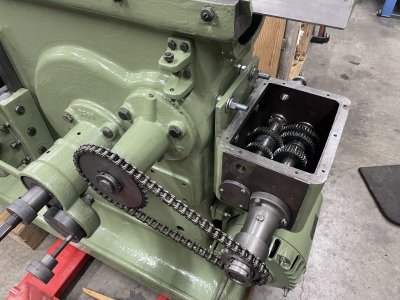
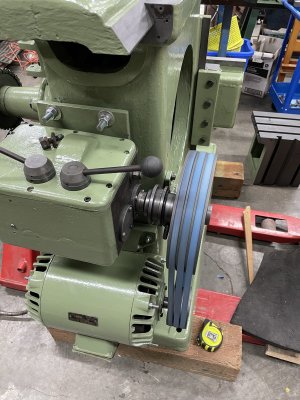
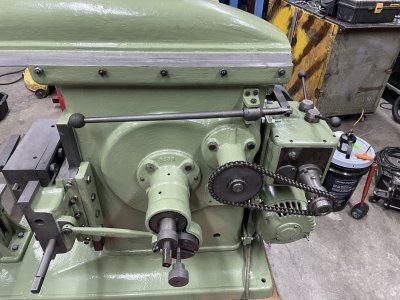
Got the motor and tranny mounted this past weekend, changed out the chain to one w/adjustable linkage, and affixed 3 new belts.
The tranny bolts on w/4 bolts to the main casting. To adjust chain tension the bolts had been let out and a 1/4 flat bar was inserted behind as a shim. I changed this out to use 4 studs w/adjusting nuts instead. This makes chain adjustments easy. First two pics show it bolted (no pic of the sagging chain which prompted the use of the stud, picture #3 shows the changeover to studs).
The clutch mechanism is currently still disassembled as I need to make new engagement-shoes. Happy to say the motor runs smoothly and the tranny functions as expected (engaging clutch with a piece of wood. The yoke is out as well so the ram has yet to move.
Went with ISO68 in the gearbox. Original design - no drain plug. I drilled/tapped one in as an upgrade.





I am so envious.
Gearhead88
Ultra Member
I just read this whole thread , very Ambitious !!! , awesome build !!!
It is Shrouded in mystery! not really, but I managed to get the belt/chain shrouds mounted, and the table on the apron
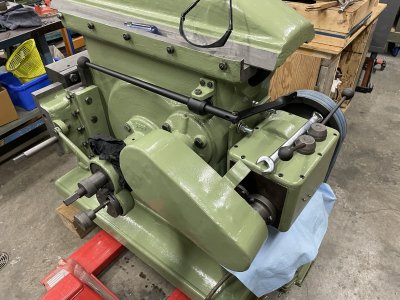
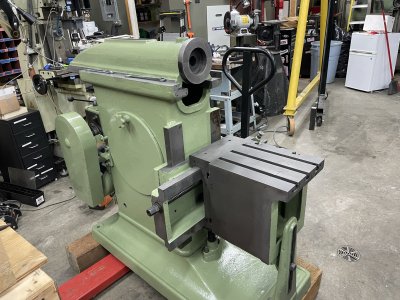
Ok, and the final piece to address is the broken casting that supports the yoke. I with with a couple pieces of 2" square steel machined out to the original shape. I used a piece of 3/8" plate to join them (slotted both pieces) etc.
I pre-bored the two pieces and 'attempted' to weld the assembly up using pins to align. It worked 'ok' but warping/deflection is inevitable. To get it aligned, I ended up using the 20-ton press and heat. The end result was nicely aligned.
Confession: Boring 1 1/8" holes is not my forte. I tried a number of methods (none on the lathe) including MT-4 drill bit (thx Tom Kitta), fly-cutter type boring (super-drill), etc.. The best solution was a 2" deep annular cutter from Amazon..... That and the mag drill. Cuts like butter.
I botched one hole badly, which led to the solution of a new-pin with two diameters. I wasn't making another piece from 2" steel.
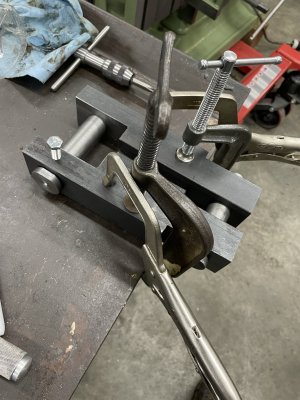
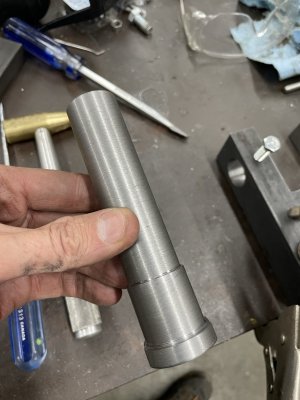
The pin has a register on it now, with flats milled so you can get a wrench on it to turn. The yoke cannot come out without the pin removed (see next pic), and you can't hammer out the pin from the other side. This way, the next time it will be easier.
Reinstalling the yoke , tight tolerances,
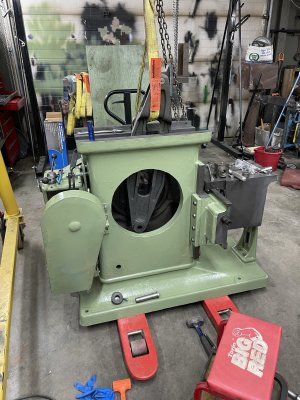
and finally.................... Ram attached and the rest of the finer bits assembled.
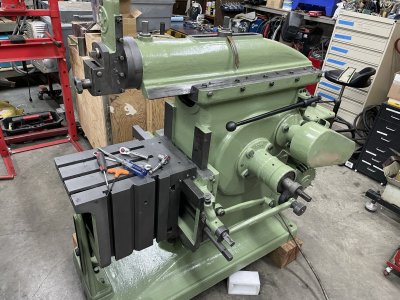
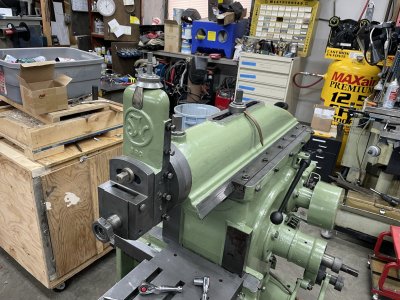


Ok, and the final piece to address is the broken casting that supports the yoke. I with with a couple pieces of 2" square steel machined out to the original shape. I used a piece of 3/8" plate to join them (slotted both pieces) etc.
I pre-bored the two pieces and 'attempted' to weld the assembly up using pins to align. It worked 'ok' but warping/deflection is inevitable. To get it aligned, I ended up using the 20-ton press and heat. The end result was nicely aligned.
Confession: Boring 1 1/8" holes is not my forte. I tried a number of methods (none on the lathe) including MT-4 drill bit (thx Tom Kitta), fly-cutter type boring (super-drill), etc.. The best solution was a 2" deep annular cutter from Amazon..... That and the mag drill. Cuts like butter.
I botched one hole badly, which led to the solution of a new-pin with two diameters. I wasn't making another piece from 2" steel.


The pin has a register on it now, with flats milled so you can get a wrench on it to turn. The yoke cannot come out without the pin removed (see next pic), and you can't hammer out the pin from the other side. This way, the next time it will be easier.
Reinstalling the yoke , tight tolerances,

and finally.................... Ram attached and the rest of the finer bits assembled.


So what's left? Ball-oiler/oil-cups all around (on order), and alignment, alignment alignment. I am in the process of adjusting the GIB on the ram, and this is going better and better. The machine has 4 speeds, and it works in the first two, but the higher gears (faster) stall the motor (no belt slip, just stalls the motor). I'm getting too much resistance on the return stroke which from the research is all about the adjustment.
Getting the yoke in place was a lot of work -- every inch (actually, every 1/2 inch) of room inside is required. The transmission was originally mounted with 4 studs into the casting. 3 out of the 4 were in bad shape, so I enlarged/re-tapped for a new stud and on the inside I put a 1/2" nut on the back of the stud........ Well, the width of the nut interferes with the yoke on the return stroke.
I also have some thoughts on how the casting broke internally. On the bull-gear, the stroke-adjustment screw was damaged -- (mushroomed out). I suspect that the stroke was cranked all the way out (and then some once the bolt was forced). This caused the yoke to come back just slightly more than it was allowed to, hitting the web on the casting (busting it out) and causing the crack. There is zero room for play in there, and the eventual wear likely led to the downfall.
Getting the yoke in place was a lot of work -- every inch (actually, every 1/2 inch) of room inside is required. The transmission was originally mounted with 4 studs into the casting. 3 out of the 4 were in bad shape, so I enlarged/re-tapped for a new stud and on the inside I put a 1/2" nut on the back of the stud........ Well, the width of the nut interferes with the yoke on the return stroke.
I also have some thoughts on how the casting broke internally. On the bull-gear, the stroke-adjustment screw was damaged -- (mushroomed out). I suspect that the stroke was cranked all the way out (and then some once the bolt was forced). This caused the yoke to come back just slightly more than it was allowed to, hitting the web on the casting (busting it out) and causing the crack. There is zero room for play in there, and the eventual wear likely led to the downfall.
Still not sure on the manufacturer, but I've seen some machines by Jochnick & Norrman that look 'similar'. If you stare hard enough at the down-feed you can kind of see a J, maybe an N? They are/were based out of Sweden, and this machine was definitely from over there.
It's flippin beautiful!
Great job Kevin!! I agree with John N., it's beautiful.
On the vertical, there is on the tool-post down-feed crank there is a graduated dial (so you can measure it off) -- but not on the kneeDoes this machine have graduated dials indicating H/V table displacement? I'm not seeing any in the images.
On the horizontal, there is a graduated dial on the crank to indicate how much step over is occurring etc.
